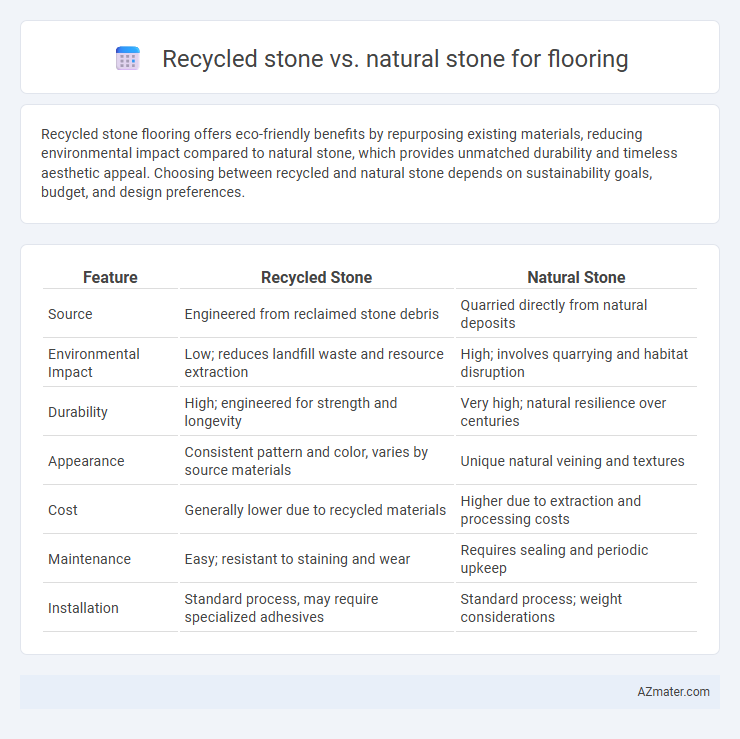Recycled stone flooring offers eco-friendly benefits by repurposing existing materials, reducing environmental impact compared to natural stone, which provides unmatched durability and timeless aesthetic appeal. Choosing between recycled and natural stone depends on sustainability goals, budget, and design preferences.
Table of Comparison
| Feature | Recycled Stone | Natural Stone |
|---|---|---|
| Source | Engineered from reclaimed stone debris | Quarried directly from natural deposits |
| Environmental Impact | Low; reduces landfill waste and resource extraction | High; involves quarrying and habitat disruption |
| Durability | High; engineered for strength and longevity | Very high; natural resilience over centuries |
| Appearance | Consistent pattern and color, varies by source materials | Unique natural veining and textures |
| Cost | Generally lower due to recycled materials | Higher due to extraction and processing costs |
| Maintenance | Easy; resistant to staining and wear | Requires sealing and periodic upkeep |
| Installation | Standard process, may require specialized adhesives | Standard process; weight considerations |
Introduction to Recycled and Natural Stone Flooring
Recycled stone flooring utilizes repurposed stone materials such as crushed concrete, glass, and industrial byproducts, offering a sustainable alternative to traditional flooring. Natural stone flooring, including granite, marble, limestone, and slate, is quarried directly from the earth, prized for its durability, unique textures, and timeless aesthetic appeal. Both options provide distinct environmental impacts, cost factors, and maintenance requirements critical for informed flooring decisions.
What is Recycled Stone Flooring?
Recycled stone flooring consists of materials repurposed from crushed concrete, glass, or processed stone waste, offering an eco-friendly alternative to natural stone floors. It provides similar durability and aesthetic appeal while reducing environmental impact by diverting waste from landfills and conserving natural quarries. This sustainable flooring option is increasingly popular in green building projects seeking LEED certification or aiming to lower their carbon footprint.
What is Natural Stone Flooring?
Natural stone flooring consists of durable, high-quality materials such as granite, marble, limestone, and slate, sourced directly from quarries. This flooring type offers unique textures and patterns formed by natural geological processes, ensuring each tile's authenticity and aesthetic appeal. Its strength and longevity make natural stone a preferred choice for both residential and commercial flooring projects seeking timeless elegance.
Environmental Impact Comparison
Recycled stone flooring significantly reduces environmental impact by diverting construction and demolition waste from landfills and lowering the demand for quarrying, which preserves natural landscapes and reduces habitat destruction. Natural stone extraction involves high energy consumption and greenhouse gas emissions due to quarrying operations and transportation, contributing to ecosystem disruption and increased carbon footprint. Choosing recycled stone promotes sustainable building practices through resource conservation and reduced environmental degradation compared to traditional natural stone flooring.
Durability and Longevity
Recycled stone flooring offers comparable durability to natural stone by utilizing crushed stone and binding agents, making it resistant to wear and heavy foot traffic. Natural stone, such as granite or marble, provides exceptional longevity due to its dense mineral composition and innate strength, often lasting decades or even centuries with proper maintenance. Both options demonstrate high resilience, but natural stone generally outperforms recycled stone in terms of long-term structural integrity and weather resistance.
Aesthetic Differences
Recycled stone flooring often features a unique, variegated appearance due to its composite materials, offering a more rustic and eco-friendly aesthetic compared to the uniform and timeless elegance of natural stone. Natural stone displays distinct, natural variations in color and veining, providing a luxurious and sophisticated look that enhances interior design. The choice between recycled and natural stone flooring significantly impacts the visual texture and ambiance of a space, with recycled stone leaning toward contemporary styles and natural stone favoring classic, high-end finishes.
Cost Analysis
Recycled stone flooring typically offers significant cost savings compared to natural stone due to lower material and manufacturing expenses, often reducing overall project budgets by 20-40%. Installation costs for recycled stone can be comparable to natural stone, but maintenance is generally more affordable because recycled materials are often more resistant to stains and wear. Long-term cost analysis favors recycled stone in sustainable building projects where budget constraints and environmental impact are priorities.
Installation Process and Maintenance
Recycled stone flooring often requires more precise substrate preparation and adhesive selection to ensure proper bonding due to its variable composition, whereas natural stone typically allows for more straightforward installation using traditional methods like thin-set mortar or cement. Maintenance of recycled stone floors involves regular cleaning with pH-neutral products to prevent surface degradation, while natural stone demands periodic sealing to protect against staining and wear. Both options benefit from routine inspections to address potential cracks or chips, but recycled stone may need more frequent attention due to its composite nature.
Popular Uses and Design Applications
Recycled stone flooring offers sustainable solutions commonly used in eco-friendly residential and commercial projects, combining durability with unique, variegated textures ideal for modern and industrial designs. Natural stone is favored for luxurious applications such as marble or granite countertops and flooring in high-end homes, hotels, and public spaces, prized for its timeless elegance and natural color variation. Both materials provide versatile design options, with recycled stone excelling in contemporary, environmentally conscious aesthetics while natural stone supports classic, sophisticated interiors.
Which Stone Flooring is Right for You?
Recycled stone flooring offers an eco-friendly and cost-effective alternative to natural stone, utilizing materials like crushed concrete and reclaimed stone to reduce environmental impact while maintaining durability. Natural stone, such as granite, marble, or limestone, provides timeless elegance, superior strength, and unique patterns, making it ideal for luxury or high-traffic areas. Choosing the right stone flooring depends on your budget, aesthetic preference, and sustainability goals, with recycled stone suited for green-conscious projects and natural stone offering premium quality and long-term value.

Infographic: Recycled stone vs Natural stone for Flooring
 azmater.com
azmater.com